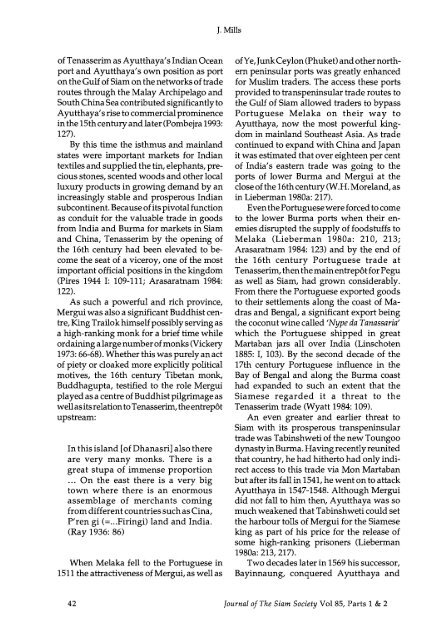The Journal of the Siam Society Vol. LXXXV, Part 1-2, 1997 - Khamkoo
The Journal of the Siam Society Vol. LXXXV, Part 1-2, 1997 - Khamkoo
The Journal of the Siam Society Vol. LXXXV, Part 1-2, 1997 - Khamkoo
Create successful ePaper yourself
Turn your PDF publications into a flip-book with our unique Google optimized e-Paper software.
J. Mills<br />
<strong>of</strong> Tenasserim as A yutthaya' s Indian Ocean<br />
port and Ayutthaya's own position as port<br />
on <strong>the</strong> Gulf <strong>of</strong> <strong>Siam</strong> on <strong>the</strong> networks <strong>of</strong> trade<br />
routes through <strong>the</strong> Malay Archipelago and<br />
South China Sea contributed significantly to<br />
A yutthaya' s rise to commercial prominence<br />
in <strong>the</strong> 15th century and later (Pombejra 1993:<br />
127).<br />
By this time <strong>the</strong> isthmus and mainland<br />
states were important markets for Indian<br />
textiles and supplied <strong>the</strong> tin, elephants, precious<br />
stones, scented woods and o<strong>the</strong>r local<br />
luxury products in growing demand by an<br />
increasingly stable and prosperous Indian<br />
subcontinent. Because <strong>of</strong> its pivotal function<br />
as conduit for <strong>the</strong> valuable trade in goods<br />
from India and Burma for markets in <strong>Siam</strong><br />
and China, Tenasserim by <strong>the</strong> opening <strong>of</strong><br />
<strong>the</strong> 16th century had been elevated to become<br />
<strong>the</strong> seat <strong>of</strong> a viceroy, one <strong>of</strong> <strong>the</strong> most<br />
important <strong>of</strong>ficial positions in <strong>the</strong> kingdom<br />
(Pires 1944 1: 109-111; Arasaratnam 1984:<br />
122).<br />
As such a powerful and rich province,<br />
Mergui was also a significant Buddhist centre,<br />
King Trailok himself possibly serving as<br />
a high-ranking monk for a brief time while<br />
ordaining a large number <strong>of</strong> monks (Vickery<br />
1973: 66-68). Whe<strong>the</strong>r this was purely an act<br />
<strong>of</strong> piety or cloaked more explicitly political<br />
motives, <strong>the</strong> 16th century Tibetan monk,<br />
Buddhagupta, testified to <strong>the</strong> role Mergui<br />
played as a centre <strong>of</strong> Buddhist pilgrimage as<br />
well as its relation to Tenasserim, <strong>the</strong>entrepot<br />
upstream:<br />
In this island [<strong>of</strong> Dhanasri] also <strong>the</strong>re<br />
are very many monks. <strong>The</strong>re is a<br />
great stupa <strong>of</strong> immense proportion<br />
. . . On <strong>the</strong> east <strong>the</strong>re is a very big<br />
town where <strong>the</strong>re is an enormous<br />
assemblage <strong>of</strong> merchants coming<br />
from different countries such as Cina,<br />
P'ren gi (= ... Firingi) land and India.<br />
(Ray 1936: 86)<br />
When Melaka fell to <strong>the</strong> Portuguese in<br />
1511 <strong>the</strong> attractiveness <strong>of</strong> Mergui, as well as<br />
<strong>of</strong>Ye,JunkCeylon(Phuket)ando<strong>the</strong>rnor<strong>the</strong>rn<br />
peninsular ports was greatly enhanced<br />
for Muslim traders. <strong>The</strong> access <strong>the</strong>se ports<br />
provided to transpeninsular trade routes to<br />
<strong>the</strong> Gulf <strong>of</strong> <strong>Siam</strong> allowed traders to bypass<br />
Portuguese Melaka on <strong>the</strong>ir way to<br />
A yutthaya, now <strong>the</strong> most powerful kingdom<br />
in mainland Sou<strong>the</strong>ast Asia. As trade<br />
continued to expand with China and Japan<br />
it was estimated that over eighteen per cent<br />
<strong>of</strong> India's eastern trade was going to <strong>the</strong><br />
ports <strong>of</strong> lower Burma and Mergui at <strong>the</strong><br />
close <strong>of</strong> <strong>the</strong> 16th century (W .H. Moreland, as<br />
in Lieberman 1980a: 217).<br />
Even <strong>the</strong> Portuguese were forced to come<br />
to <strong>the</strong> lower Burma ports when <strong>the</strong>ir enemies<br />
disrupted <strong>the</strong> supply <strong>of</strong> foodstuffs to<br />
Melaka (Lieberman 1980a: 210, 213;<br />
Arasaratnam 1984: 123) and by <strong>the</strong> end <strong>of</strong><br />
<strong>the</strong> 16th century Portuguese trade at<br />
Tenasserim, <strong>the</strong>n <strong>the</strong> main entrepotfor Pegu<br />
as well as <strong>Siam</strong>, had grown considerably.<br />
From <strong>the</strong>re <strong>the</strong> Portuguese exported goods<br />
to <strong>the</strong>ir settlements along <strong>the</strong> coast <strong>of</strong> Madras<br />
and Bengal, a significant export being<br />
<strong>the</strong> coconut wine called 'Nype da Tanassaria'<br />
which <strong>the</strong> Portuguese shipped in great<br />
Martaban jars all over India (Linschoten<br />
1885: I, 103). By <strong>the</strong> second decade <strong>of</strong> <strong>the</strong><br />
17th century Portuguese influence in <strong>the</strong><br />
Bay <strong>of</strong> Bengal and along <strong>the</strong> Burma coast<br />
had expanded to such an extent that <strong>the</strong><br />
<strong>Siam</strong>ese regarded it a threat to <strong>the</strong><br />
Tenasserim trade (Wyatt 1984: 109).<br />
An even greater and earlier threat to<br />
<strong>Siam</strong> with its prosperous transpeninsular<br />
trade was Tabinshweti <strong>of</strong> <strong>the</strong> new Toungoo<br />
dynastyinBurma.Havingrecentlyreunited<br />
that country, he had hi<strong>the</strong>rto had only indirect<br />
access to this trade via Mon Martaban<br />
but after its fall in 1541, he went on to attack<br />
Ayutthaya in 1547-1548. Although Mergui<br />
did not fall to him <strong>the</strong>n, Ayutthaya was so<br />
much weakened that Tabinshweti could set<br />
<strong>the</strong> harbour tolls <strong>of</strong> Mergui for <strong>the</strong> <strong>Siam</strong>ese<br />
king as part <strong>of</strong> his price for <strong>the</strong> release <strong>of</strong><br />
some high-ranking prisoners (Lieberman<br />
1980a: 213, 217).<br />
Two decades later in 1569 his successor,<br />
Bayinnaung, conquered Ayutthaya and<br />
42<br />
<strong>Journal</strong> <strong>of</strong> <strong>The</strong> <strong>Siam</strong> <strong>Society</strong> <strong>Vol</strong>85, <strong>Part</strong>s 1 & 2

















